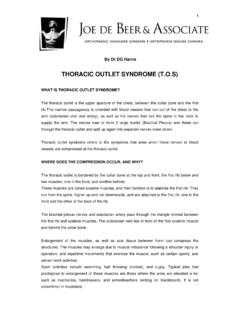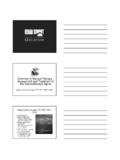Transcription of Conditions peculiar to the hands - Taylor & Francis
1 4/19/05 13:55PM Page 143. 5. Conditions peculiar to the hands The hand is mankind's greatest physical asset and, anatomically, one of his most distinctive features. It has enabled humans to use the tools that their brains have invented, and is indispensable to their well-being. Everything that the doctor does to the hand should be aimed at restoring or maintaining its function. When you examine the hand there are four sys- tems to assess: the muscles, bones and joints; the cir- culation; the nerves; and the skin and connective tissues. The general examination of these systems is described in other chapters, but the important points relating to the hand are repeated here and FIG The large spade-like fingers and hands of acromegaly. assembled into a system of examination designed to ensure that you do not miss any important Movement abnormalities. Check the range and ease of movement of all the joints: A PLAN FOR THE EXAMINATION OF the carpometacarpal joint of the thumb THE HAND (flexion, extension, abduction, adduction and opposition), Examine each system in turn.
2 The metacarpophalangeal joints of the fingers (flexion, extension, abduction and adduction), the interphalangeal joints (flexion and The musculoskeletal system (bones, extension). joints, muscles and tendons). Inability to move these joints may be caused by Inspection joint disease, soft-tissue thickening, divided tendons or paralysed muscles. Look for any abnormality of the shape, size and contour of the hand. Look for local discolouration, scars and sinuses. Look for muscle wasting by The circulation assessing the size of the thenar and hypothenar emi- nences and the bulk of the muscles between the Inspection metacarpal bones (the interossei). Look at the wrist Pallor of the fingers indicates arterial insufficiency joint. or anaemia. During an episode of vasospasm the fingers may be white or blue. Observe the degree of Palpation filling of the veins on the back of the hands .
3 Ischaemic Feel the bony contours, the tender areas, and any atrophy of the pulps of the fingers makes the fingers localized swellings. Feel the finger joints to assess thin and pointed. Ischaemic ulcers, small abscesses the cause of any swelling of these joints. and even frank gangrene may be visible. 4/19/05 13:55PM Page 144. 144 Conditions peculiar to the hands Palpation Feel the temperature of the skin of each finger. Feel both pulses (radial and ulnar) at the wrist. Sometimes the digital arteries can be felt on either side of the base of the fingers. Capillary return A crude indication of the arterial inflow to the fingers can be obtained from watching the rate of filling of the vessels beneath the nail after emptying them by pressing down on the tip of the nail. FIG Acrocyanosis. A persistent blue discolouration of the Allen's test Ask the patient to clench one fist tightly skin of the hands caused by mild vasospasm, usually induced and then compress the ulnar and radial arteries at by a drop in ambient temperature.
4 The wrist with your thumbs. After 10 seconds, ask the patient to open the hand. The palm will be white. Release the compression on the radial artery and watch the blood flow into the hand. Slow flow into one finger caused by a digital artery occlusion will be apparent from the rate at which that finger turns pink. Repeat the procedure, but release the pressure on the ulnar artery first. Auscultation Listen with the bell of your stethoscope over any abnormal areas. Vascular tumours and arteriovenous fistulae may produce a bruit, sometimes a palpable FIG Vitiligo (loss of pigmentation) in a dark-skinned thrill. patient. Measure the blood pressure in both arms. The nerves Sensory nerves When there is loss of sensation you must find out which type of sensation is lost ( light touch, pain, position sense, vibration sense), as described in Chapter 1, and the distribution of the sensory loss.
5 Does it correspond to the innervation of one nerve or to a dermatome? The following gives details of the areas of skin innervated by the three nerves of the hand. FIG Inflammatory changes at the wrist. Such findings Median nerve The median nerve innervates the pal- often occur from superficial thrombophlebitis when an mar aspect of the thumb, index and middle fingers, intravenous infusion site becomes inflamed. In this patient the dorsal aspect of the distal phalanx and half of the this was flitting thrombophlebitis migrans secondary to middle phalanx of the same fingers, and a variable carcinoma of the pancreas. amount of the radial side of the palm of the hand. DISTRIBUTION OF THE NERVES OF THE UPPER LIMB. 4/19/05. Median nerve Ulnar nerve Radial nerve 13:55PM. Triceps (Extend the elbow). Page 145. Brachioradialis Flexor digitorum sublimis Flexor carpi ulnaris Lateral half of flexor Medial half of flexor digitorum profundus profundus (Adduct Extensor digitorum (Flex the index finger) the wrist) (Extend the wrist).
6 Muscles of hypothenar eminence Opponens and abductor Interossei pollicis (Lift the thumb Adductor pollicis away from the palm) (Abduct the little finger). Posterior Anterior Posterior Anterior Posterior Anterior FIG 4/19/05 13:55PM Page 146. 146 Conditions peculiar to the hands Ulnar nerve The ulnar nerve innervates the skin on the anterior and posterior surfaces of the little fin- ger and the ulnar side of the ring finger, the skin over the hypothenar eminence, and a similar strip of skin posteriorly. The ulnar nerve sometimes inner- vates all of the skin of the ring finger and the ulnar side of the middle finger. Radial nerve This innervates a small area of skin over the lateral aspect of the first metacarpal and the back of the first web space. The dermatomes of the hand are: C6 thumb FIG A positive Froment's test on the right hand ( on the C7 middle finger left of the picture) indicating an ulnar nerve palsy and C8 little finger.
7 Inability to adduct the thumb due to paralysis of adductor pollicis. This means that the thumb flexes to grip paper due Motor nerves to contraction of the flexor pollicis longus. The muscles that control the movements of the hand lie within the hand and in the forearm ( fractures of the medial epicondyle, lacerations at the they are intrinsic and extrinsic). All the long flexors wrist and long-standing marked cubitus valgus, may and extensors of the fingers lie in the forearm, and present as follows. the nerves that innervate them leave their parent If the injury is at wrist level: nerves at or above the elbow. wasting of the hypothenar eminence and The nerves that innervate the intrinsic muscles hollows between the metacarpals have a long course in the forearm before they reach absence of flexion of the little and ring the hand. Thus it is necessary to examine all the fingers motor functions of the three principal nerves in the claw hand, with ring and little finger upper limb (median, ulnar and radial) if you wish hyperextended at the metacarpophalangeal to find the level at which a nerve is damaged.
8 A rapid joint and flexed at the interphalangeal assessment of the motor function of these three joints nerves in the hand can be obtained by looking for absence of adduction and abduction of the the following physical signs. fingers with a positive Froment's test. A median nerve palsy, which may follow pene- trating injuries, lacerations at the wrist, dislocation If the injury is at the level of the elbow: of the carpal tunnel and carpal tunnel compression, wasting of intrinsic muscles may present as follows. claw hand, but with terminal interphalangeal If the injury is at wrist level: joints not flexed as half of flexor digitorum wasting of the thenar eminence profundus now paralysed absent abduction of the thumb positive Froment's test. absent opposition of the thumb. If the injury is high above the elbow: If the injury is at or above the cubital fossa: all the above wasting of the forearm and thenar eminence the flexor carpi ulnaris also paralysed.
9 Loss of flexion of the thumb and index finger A radial nerve palsy, which may follow fractures hand held in the benediction position, with of the shaft of the humerus, penetrating injuries and ulnar fingers flexed and index finger straight. pressure in the axilla from prolonged resting with An ulnar nerve palsy, which may follow damage the arm suspended over a chair or over a crutch, or compression at the elbow, penetrating injuries, may present in the following ways. 4/19/05 13:55PM Page 147. A plan for the examination of the hand 147. FOUR QUICK TESTS OF THE MOTOR AND SENSORY INNERVATION OF THE HAND. Motor innervation Radial nerve Ulnar nerve Median nerve Abduct the thumb Extend the wrist Abduct the fingers Sensory innervation Test sensation in these three areas Index finger Median nerve Little finger Ulnar nerve Lateral aspect of base of thumb Radial nerve FIG If there is an injury in the axilla: If the injury is to the posterior interosseous: absence of extension of the wrist (wrist drop) hand held in radial deviation when attempting loss of triceps action.
10 Extension no wrist drop If the injury is at the level of the middle third of an inability to maintain finger extension against humerus: forcible flexion. wrist drop If the injury is to a superfical branch of the nerve: sparing of the brachioradialis (when paralysed, this weakens elbow flexion). no motor loss. 4/19/05 13:55PM Page 148. 148 Conditions peculiar to the hands FIG The abnormal palmar creases associated with Down's syndrome. FIG Arachnodactyly long spindly fingers associated with Marfan's syndrome (see page 220). The examination of the motor function of these three nerves can be simplified by using three screen- ing tests: 1. median nerve: abduction of the thumb;. 2. ulnar nerve: abduction of the little finger;. 3. radial nerve: extension of the wrist. As you perform each of these tests, feel the mus- FIG The hyperextensibility of the thumb and cle you are testing to check whether or not it is metacarpophalangeal joints of Ehlers Danlos syndrome.








